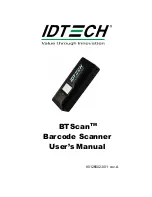
Glossary of Terms
A-32
MS-860 Industrial Raster Reader User’s Manual
Embedded Memory. Onboard memory device such as EPROM or flash.
End of Read Cycle. The time or condition at which the reader stops expecting symbol
information to decode.
Edge. Allows a read cycle to be initiated by a trigger signal from an object detector
when it detects the appearance of an object (rising edge). The read cycle ends with a
good read, a timeout, or a new trigger.
ESP. Easy Setup Program. A portable proprietary Windows/NT based program devel-
oped by Microscan Systems, Inc.
Falling Edge. A change of state (to inactive) associated with a level trigger in which
the reader stops searching for symbols. (See
Rising Edge.)
Fixed Code Length. Increases data integrity by ensuring that only one symbol length
will be accepted.
Flash Memory. Memory that can be changed by downloading new code and recalled on
power-on.
Focal Length. The distance measured from the reader to the center of the depth of
field, or
focal
point.
Focus. The point at which the tip of the scan beam is at its narrowest.
Full Duplex. Auxiliary port data is sent directly to the host but not displayed on the
auxiliary port screen.
Gain. Optimal signal strength.
Good Match. The event occurring when a scanned symbol matches the master symbol
information that is stored in the memory of the device.
Good Read. A decode. The successful scanning and decoding of the information
encoded in a symbol.
Half Duplex. Auxiliary port data is sent directly to the host and displayed on the auxil-
iary port screen.
Host. A computer, PLC, or other device that is used to execute commands and process
data and discrete signals.
Host Port. The pins or connections on a reader or other device that physically connect
with a host and—using the RS-232, RS-422, or RS-485 standards—pass data and serial
commands from one device to another.
Initialize. Implement serial configuration commands into the reader’s active memory.
Input. A channel or communications line. Decoded data or a discrete signal that is
received by a device. See Output.
Intercharacter Delay. The time interval in milliseconds between individual characters
transmitted from the reader to the host.
Intercharacter Gap. The extra space between the last element of one character and
the first element of the adjacent character of a specific bar code symbol.
Ladder Symbol Orientation. A bar code symbol in which the bars are parallel to the
symbol’s direction of travel.
Large Intercharacter Gap. Allows the reader to read symbols with gaps between
symbol characters that exceed three times (3x) the narrow element width.
Artisan Technology Group - Quality Instrumentation ... Guaranteed | (888) 88-SOURCE | www.artisantg.com
















































